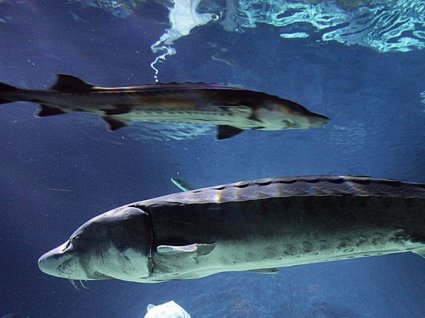Ancient Creature on Brink
of Extinction in Yangtze River, China
As the mountains rose from the tide, as the earth’s plates collided, as the tides receded to reveal the land- as the seas changed, one thing remained constant in the ever changing currents: the Chinese Sturgeon. This fish has thought to have lived in the murky depths of the Yangtze River for more than 140 million years. Now the Sturgeon, that has swam in the shadows for so long, may completely disappear.
The Chinese Sturgeon can reach up to 16 feet in length and weigh on average 1,000 pounds. Nicknamed the ‘living fossil,’ it is a breathing portrait of what scientists believe a fish thriving in the prehistoric seas would have looked like (BBC News). This massive fish has rumored to be traveling the East Chinese Sea since the reign of the dinosaurs, but modern technology has made them an endangered species. The sturgeon migrate from the East Chinese Sea to the Yangtze River, a 2,000 mile journey upstream, to reproduce. After dozens of dams were constructed in the Yangtze River, the Chinese Sturgeon’s population dropped steadily (BBC News).
As reported by Discovery News, the Chinese Sturgeon, because of the tribulations it has had to face, did not reproduce naturally in the 2013 breeding season. This is the first time in the 32 years researchers have been studying this incredible fish that reproduction did not occur (Discovery News). Not a single Sturgeon was recorded to have laid eggs in their usual spawning ground. This is a devastating setback to this ancient creature’s vital climb out of their endangered species status. “‘No natural reproduction means that the sturgeons would not expand its population and without protection, they might risk extinction,” Wei Qiwei, an investigator with the academy, told China's official Xinhua news agency on Saturday” (Discovery News). Its extinction would not only be a tremendous blow to the scientific community, but also to the ecosystem the Sturgeon contributes to.
The unique residents that swim in the banks of the Yangtze River have suffered greatly from the building of the dams. Plus the overfishing, the incessant disruption from shipping traffic, and the shockingly high levels of water pollution have only diminished the Sturgeon’s chances of survival. The Finless Porpoise and the Chinese Alligator will also face complete annihilation if the above factors keep occurring in their river. The negative impact of humans have put the Sturgeons and many other forms of life in the Yangtze River in dire straits (National Geographic).
To keep this ancient fish swimming, the Chinese government has attempted to replenish the Sturgeons’ population. They’ve created a sanctuary designated for a new spawning ground for the sturgeon away from the influence of the dams, but changing a 140 million year migratory cycle is not that easy. They have also bred the carnivorous Sturgeon’s primary food source, the fry, in large numbers in captivity and released them in the wild so finding food is not a challenge. Although these are solid efforts, there has been little improvement as of yet (National Geographic).
While the extinction of this ancient creature may seem inevitable, the Chinese Sturgeons haven’t lived 140 million years without learning a few tricks. Its long history in the Earth’s seas is not all smooth tides and crystal clear waters. “Sturgeons may face long odds, but the fish has survival in its genes… Some reports suggest the sturgeon may already be adapting to its changing environment. Studies suggest its diet is shifting from less abundant bottom dwellers, like clams, to more plentiful earthworms” (National Geographic). This adaptive behavior is a skill necessary for the Sturgeon’s survival.
This ancient creature may have thick scales to combat the always changing waters, but extinction is still a possible future for them. While their small improvement is a step in the right direction, the Chinese Sturgeon still have seemingly insurmountable hurdles ahead of them.
Today, the Chinese sturgeon – one of the oldest living species of animal on Earth – have been reduced to a population of only about 100. “Last year, there was no evidence found of their natural reproduction anywhere along their usual habitat. If action is not taken immediately, they will go extinct…” as Lindsey Weedston of Animal Petitions wrote in her petition letter to the Minister of Environmental Protection in China, Zhou Shengxian.
Calling the Chinese Sturgeon “one of the most treasured Chinese icons,” Animal Petition is one of many wildlife conservation organizations that are speaking up to protect one of the oldest living creatures on Earth today. Without their efforts, the extinction of this ancient fish would have gone unnoticed. It likely would not have been found again until hundreds of years later where it would be found in the riverbed of the Yangtze River as fossils, reunited with the dinosaurs that it was born with 140 million years ago. However, its struggle against extinction has been brought to light, which is the first step in every conservation effort. If conservationists and the Chinese government can work collaboratively to reduce pollution and other negative human impacts in the Yangtze River, the Chinese Sturgeon has a chance for 140 million more years on Earth.
 10 Shockingly Profitable and Illegal World Trades
10 Shockingly Profitable and Illegal World Trades
 Nigerian Businesswomen Demolish Boy's Club in Oil Industry
Nigerian Businesswomen Demolish Boy's Club in Oil Industry




 writer714
writer714